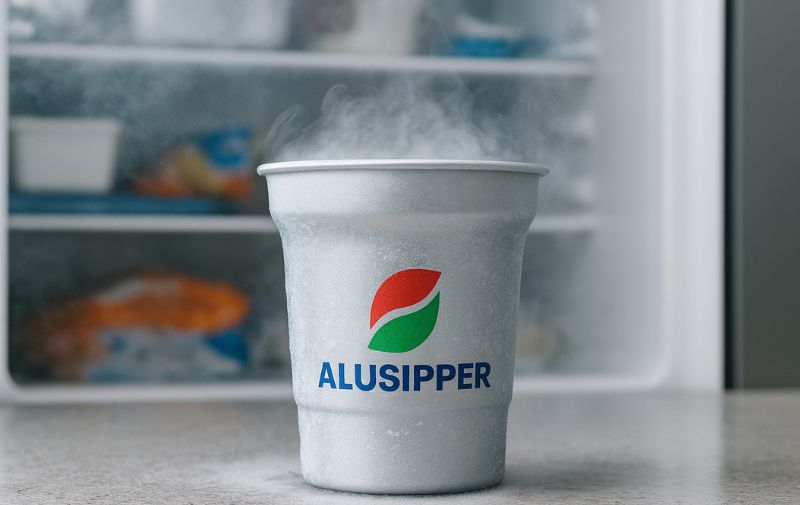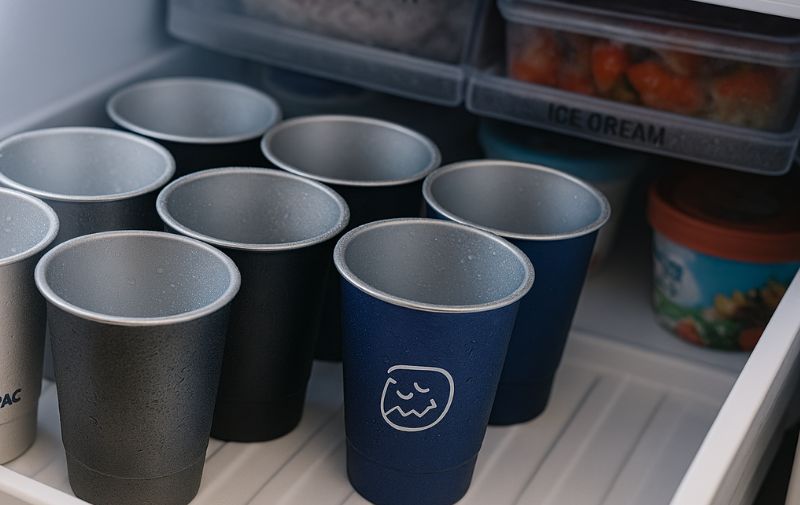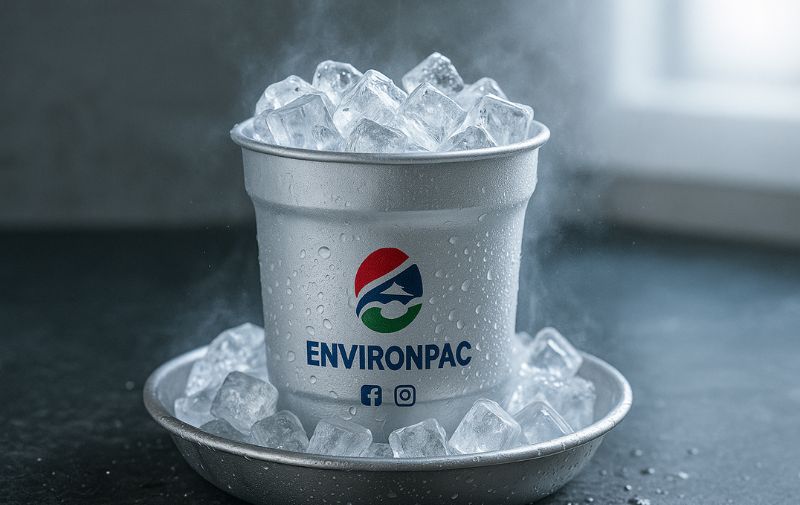Table of Contents
In pursuit of the ultimate ice-cold beverage experience, you might have wondered: “Can you put aluminum cups in the freezer?” The answer is: yes, but with very important caveats! Pre-chilling an empty aluminum cup can make your drink extra frosty, but freezing an aluminum cup with liquid inside comes with risks. This article will delve into the best practices for safely freezing aluminum cups and the potential issues you need to be aware of.
Last Updated: 16th.June 2025 | Estimated Reading Time: 12 minutes
Chilling Out: Understanding Aluminum, Metal Cups, and Freezers
Many people search “can metal cups go in the freezer” or “can you put aluminum cups in the freezer” because they crave an extra cold drink. An ice-cold cup not only helps keep beverages chilled longer but also provides a refreshingly frosty touch.
The “Why”: The Allure of a Frosty Mug
Aluminum’s thermal conductivity is a huge advantage here. Aluminum transfers temperature very efficiently. So, an aluminum cup will get very cold, very fast in the freezer, much quicker than glass or ceramic. This rapid chilling is a key benefit people seek. Imagine sipping an ice-cold beer or lemonade from a frosted aluminum cup on a hot summer day – that cooling experience is unparalleled!

The Big Chill: What Happens to Aluminum in Freezer Temperatures?
Unlike some plastics that can become brittle and crack at freezer temperatures, aluminum (and most metals suitable for drinkware, like stainless steel) performs exceptionally well in the cold. It does not lose its structural integrity or become fragile. From a purely structural standpoint of the empty cup, this inherent cold tolerance makes aluminum a better candidate for freezer chilling than many other materials.
Practical Tip: Before placing a dry, empty aluminum cup in the freezer, you can wrap the outside with a slightly damp paper towel (ensure it’s just damp, not dripping). This can help the cup form a thin layer of frost faster for a better visual effect, but be careful of sticking when removing it.
The Elephant in the Freezer: Liquid Expansion Risks!
This is the most important consideration, and it applies to any sealed or overly full container of liquid, not just aluminum. Water (and water-based beverages) expand when they freeze. If you put a full, sealed aluminum cup of liquid in the freezer, the expanding ice can exert enormous pressure.
Potential Outcomes:
- Deformation: The cup can bulge or become misshapen.
- Rupture/Bursting: The seams can split, or the cup itself can burst, creating a mess and potentially damaging your freezer or other contents. This is especially true for thinner, single-use style aluminum cups, but even sturdier reusable ones can be damaged.
- Damage to Lids: If it’s a cup with a lid, the lid can be forced off or damaged.
My Strong Recommendation: NEVER freeze a full, sealed aluminum cup (or any metal cup) containing liquid! This is key to ensuring safety and protecting your property.
| Freezing Method | Risk Level | Potential Outcomes | What It Means for You |
|---|---|---|---|
| Freezing an Empty Aluminum Cup | Low | Cup chills safely | Safely get a frosty cup, enhancing your drink experience. |
| Freezing an Open Aluminum Cup with a Small Amount of Liquid | Medium | Liquid may overflow, freeze unevenly; slight risk of cup deformation | Handle with care, leave ample expansion space, not recommended. |
| Freezing an Aluminum Cup Full of Liquid (Open Top) | High | Significant overflow, cup deformation, difficult to remove solid ice | Highly not recommended, may damage cup, messy cleanup. |
| Freezing a Full, Sealed Aluminum Cup | Extremely High | Cup bursting, freezer damage, liquid spillage, safety hazard! | Absolutely forbidden! This is very dangerous. |
Best Practices: Freezing Aluminum (and Metal) Cups Safely and Effectively
Now that we understand the risks, let’s look at how to properly use your freezer to enhance your aluminum cup experience.

Empty Cups in the Freezer: The Go-Ahead!
Yes, you can absolutely put empty aluminum cups in the freezer to chill them. This is a safe and effective way to get that frosty mug effect. Even 30 minutes to an hour can make a significant difference. For AluSipper coated aluminum cups, their food-grade lining is designed to be robust and won’t be negatively affected by typical freezer temperatures when the cup is empty.
Cups with Liquids: Handle with Extreme Care (Or Better Yet, Don’t)
If you absolutely must try to quick-chill a beverage inside the cup, ensure the cup is unsealed and leave at least 20-25% headspace for the liquid to expand. However, people often underestimate how much liquids expand. A better practice is to chill your beverage separately in a pitcher or its original container (if freezer-safe and designed for it) and then pour it into your pre-chilled empty aluminum cup.
Cost Consideration: Damaging a reusable aluminum cup due to ice expansion is an unnecessary expense.
Practical Tips for Pre-Chilling Your Cups
- Dry the Exterior: Wipe the outside of the cup dry before placing it in the freezer to prevent it from sticking to freezer shelves or other items.
- Handle with Care: A heavily frosted aluminum cup will be very cold to the touch. Use a napkin or coaster if holding it for an extended period, or consider cups with sleeves if this is a regular practice.
- Condensation: Be aware that a very cold cup will attract condensation quickly once removed from the freezer, especially in humid environments. Use a coaster.
- Cleanliness First: Ensure your aluminum cup is clean before freezing to prevent any off-flavors or odors.
Potential Downsides and Considerations When Freezing Aluminum Drinkware
While pre-chilling empty aluminum cups has many benefits, some details are worth noting.
Could freezing affect taste or the cup itself?
For high-quality coated aluminum cups (like AluSipper), their food-grade polymer lining is designed to withstand a wide range of temperatures, including those in a typical home freezer. Chilling an empty cup will not compromise the coating. Theoretically, repeated extreme temperature cycling over many years could stress any material, but for practical pre-chilling purposes, it’s perfectly fine.
As for taste, as long as the cup is clean before freezing, there should be no impact. However, if there are strong-smelling foods in the freezer, an empty cup (even aluminum) left for a long time might absorb some odors.
Is there a risk of “freezer burn” to the cup’s surface or any coatings?
The term “freezer burn” usually describes the dehydration and oxidation of food due to improper freezing. For an aluminum cup itself or its robust food-grade coating, this type of physical damage will not occur when freezing an empty cup at normal freezer temperatures. The coating is designed with low-temperature resistance in mind.
Any concerns with acidic or salty drinks in a frozen aluminum cup?
For high-quality coated aluminum cups with an intact food-grade lining, short-term holding of cooled acidic (like lemon juice, cola) or salty beverages is generally safe. However, it’s not recommended to store highly acidic or salty liquids in any metal container, including aluminum cups, for extended periods (hours or days), especially if attempting to freeze them. When liquid freezes, the concentration of some components might increase locally in the unfrozen parts, potentially increasing the chance of reaction with the metal (if the coating has micro-scratches) or the coating itself. Pre-chilling the empty cup and then pouring the drink is a safer option.
Safety Tip: If the inner coating of your coated aluminum cup is noticeably scratched or damaged, avoid using it for prolonged storage of acidic beverages, and certainly don’t attempt to freeze such liquids in it.
Aluminum vs. Other Materials: Is Aluminum the Best Choice for Freezer-Chilling Cups?
Each material reacts differently to low temperatures; understanding these differences helps you make the best choice.
How does freezing aluminum cups compare to freezing glass or plastic cups?
| Feature | Aluminum Cup (Empty, Frozen) | Glass Cup (Empty, Frozen) | Plastic Cup (Empty, Frozen) | What It Means for You |
|---|---|---|---|---|
| Cool-Down Speed | Very Fast | Slower | Slow | Aluminum cups achieve a frosty effect the quickest. |
| Chill Retention (Cup Body) | Fair (depends on wall thickness & environment) | Better (glass is a poor heat conductor) | Poor (plastic insulation is average) | A pre-chilled glass cup might feel cold longer, but an aluminum cup chills drinks faster. |
| Durability (Freezer Resistance) | Excellent (won’t shatter) | Fair (some glass can shatter from thermal shock) | Poor (some plastics become brittle at low temps) | Aluminum cups are safer and more durable when freezing. |
| Weight | Light | Heavier | Very Light | Aluminum cups are lightweight and easy to handle. |
| Liquid Expansion Risk (Freezing with Liquid) | Same High Risk (all materials suffer) | Same High Risk | Same High Risk | Never freeze a sealed container full of liquid, regardless of material. |
How do single-wall vs. double-wall insulated metal cups react differently to freezing?
- Single-Wall Aluminum Cups (like AluSipper’s classic models): Excellent thermal conductivity. The cup wall will become ice-cold very quickly in the freezer. When removed, this coldness is rapidly transferred to the poured-in beverage. However, it will also absorb heat from the environment quickly, and the warmth of your hand will transfer to the cup.
- Double-Wall Vacuum Insulated Metal Cups (usually stainless steel): Primarily designed for insulation (hot or cold), slowing down temperature transfer between the inside and outside. If an empty double-wall cup is placed in the freezer, mainly the inner wall will cool, but due to the vacuum layer’s insulation, its cooling speed and the “frosty feel” it can achieve are far less than a single-wall aluminum cup. They are better suited for pouring in a cold drink and relying on their own insulation to maintain the temperature. Attempting to freeze a double-wall cup for a “frosty mug” effect is largely pointless.
For Ultimate Drink Chilling: A Frozen Cup or Just Adding Ice?
This depends on the effect you’re after:
- Freezing an Empty Cup:
- Pros: Doesn’t dilute the drink, provides an initial extra chill, quickly cools the first sip. Aluminum cups especially offer a cold hand-feel.
- Cons: The total cooling capacity is limited; for a large drink, its cooling effect will gradually diminish.
- Adding Ice Cubes:
- Pros: Provides continuous and significant cooling, can keep the entire drink cold for a long time.
- Cons: Ice melts and dilutes the drink, altering the flavor.
The Best Combo? For many drinks (like beer, soda), you can pre-chill an empty aluminum cup, then pour in your chilled beverage, and add a few ice cubes if longer-lasting coldness is desired. This gives you the initial extreme chill and hand-feel, maintains some cold retention, and minimizes dilution.

2025 Insights: The Future of Chilled Drinkware
Entering 2025, consumer demands for chilled drink experiences are increasing. Beyond basic insulation, personalized designs and smarter instant cooling technologies are becoming new areas of exploration. For products like aluminum cups, concepts like lightweighting, more durable coatings, and “active cooling” cups incorporating small thermoelectric cooling modules (though not yet widespread) represent a future trend. The use of recyclable materials (like recycled aluminum) in high-end drinkware is also expected to increase.
Latest Advancements at a Glance:
- Eco-Friendly Coating Innovations: More environmentally friendly and abrasion-resistant food-grade coating technologies will continue to develop, ensuring the safety and durability of aluminum cups in various usage scenarios.
- Modular Designs: Aluminum cups with interchangeable functional accessories (like detachable chilling rings or handles) may appear, increasing usage flexibility.
- Consumer Education: Brands will focus more on educating consumers on how to properly use and maintain metal drinkware, including safe freezing methods, to extend product lifespan.
Frequently Asked Questions (FAQ)
Question 1: Will the coating on coated aluminum cups (like AluSipper) peel off from being put in the freezer?
Typically, no. High-quality food-grade polymer coatings are designed to withstand the low temperatures of a home freezer. As long as you are freezing an empty cup, the coating should not be damaged or peel due to the low temperature itself. Avoiding scratching the inner wall with sharp objects is key to protecting the coating.
Question 2: How long should I leave an aluminum cup in the freezer for optimal results?
For an empty aluminum cup, placing it in the freezer for 30 minutes to 1 hour is usually sufficient to make its body icy cold and give it a frosty appearance. Leaving it longer won’t bring significant additional benefits and might increase the risk of the cup freezing to other items in the freezer.
Question 3: Will a frozen aluminum cup be too cold to hold?
Yes, an aluminum cup just taken out of the freezer, especially a single-wall one, will have a very low surface temperature. Holding it directly might feel uncomfortable. It’s recommended to use a cup sleeve, wrap it in a napkin, or wait a few minutes for the cup wall to warm up slightly before holding.
Question 4. If I accidentally froze an aluminum cup with liquid and it deformed, can I still use it?
If the aluminum cup is only slightly deformed and has no cracks or coating damage, it might theoretically still be usable, but its appearance and stability could be affected. If it’s cracked or the coating is visibly damaged, it should no longer be used to prevent leaks or migration of metal/coating substances. To be safe, avoiding freezing cups with liquid is best.
Question 5. Does freezing affect the “recyclability” of an aluminum cup?
No. The freezing process itself does not change the chemical properties of aluminum. Whether an aluminum cup has been frozen or not, as long as it’s a clean aluminum product, it can be recycled just like other aluminum items. AluSipper aluminum cups are designed to be recyclable.
Summary and Actionable Advice
In summary, placing an empty aluminum cup in the freezer is an excellent way to quickly achieve an ice-cold drinking experience. Aluminum’s excellent thermal conductivity allows it to cool down rapidly, giving you a frosty cup and a cooler drink. AluSipper coated aluminum cups can be safely pre-chilled in the freezer when empty.
However, it is crucial to never attempt to freeze a full, sealed aluminum cup (or any material cup) containing liquid, as the expansion of freezing liquid can cause the cup to deform, crack, or even burst, leading to unnecessary damage and safety hazards.
Actionable Advice:
- Safety First: Always freeze empty aluminum cups.
- Quick & Effective: 30-60 minutes of freezing is enough to make your aluminum cup perfectly chilled.
- Smart Pairing: Combine a pre-chilled aluminum cup with a cold beverage, adding a few ice cubes as needed for optimal taste.
- Proper Care: Correctly using and cleaning your coated aluminum cup will ensure it accompanies you for many more frosty moments.
Enjoy the cool refreshment from an ice-chilled aluminum cup, but always remember to operate safely!
Recommended
- Explore the AluSipper Coated Aluminum Cup Collection: Durability Meets Style
- The Importance of Metal Recycling – The Recycling Partnership (Highlights the environmental benefits of metal recycling)







